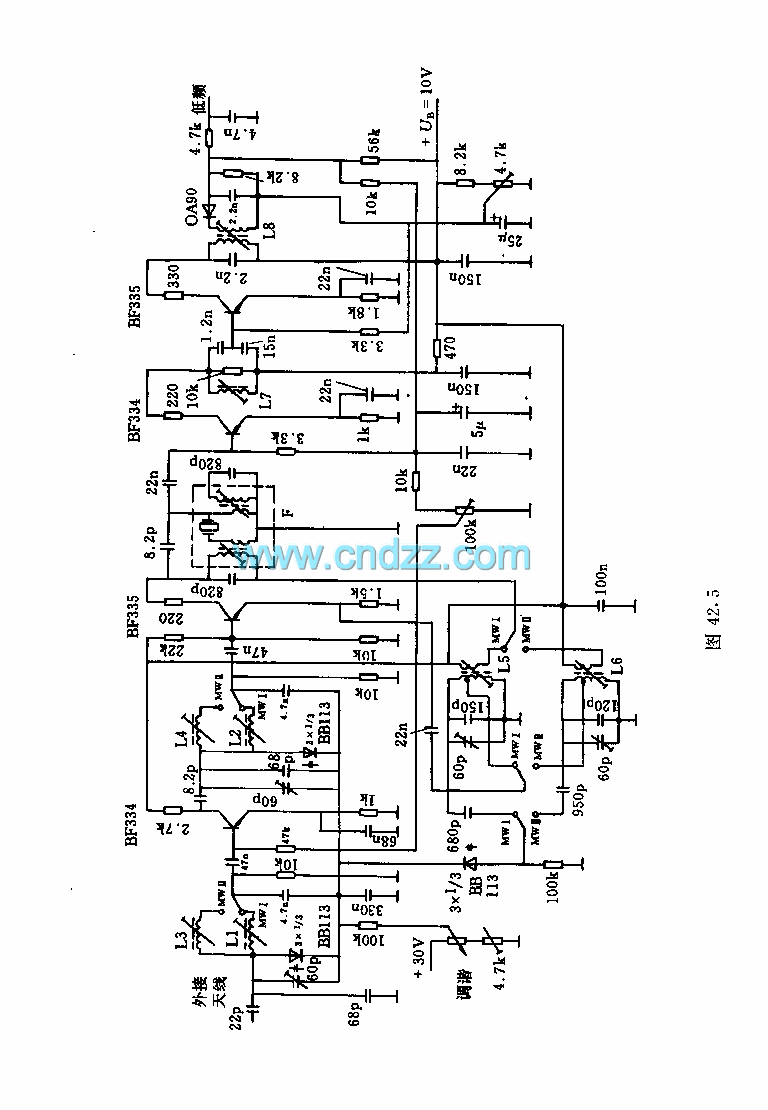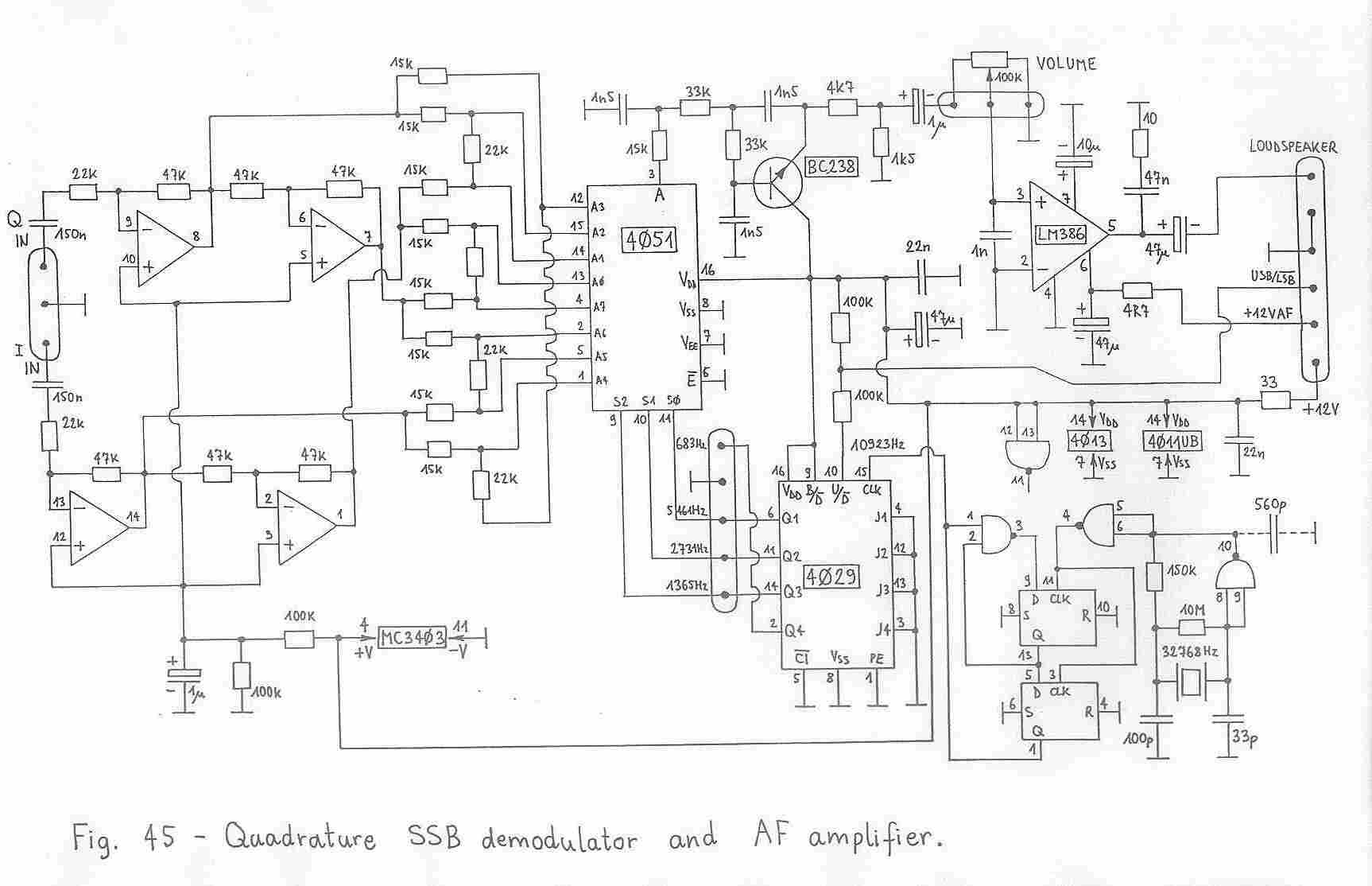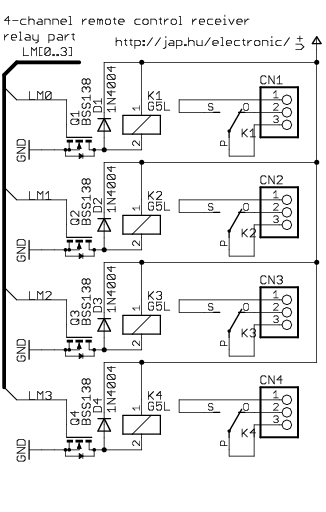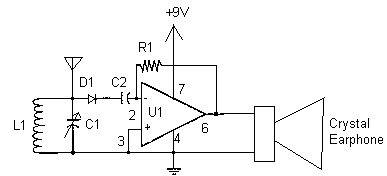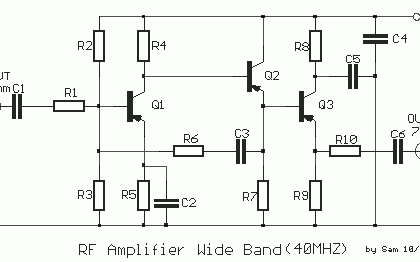
Henry Radio 5K Classic Blower Modifications
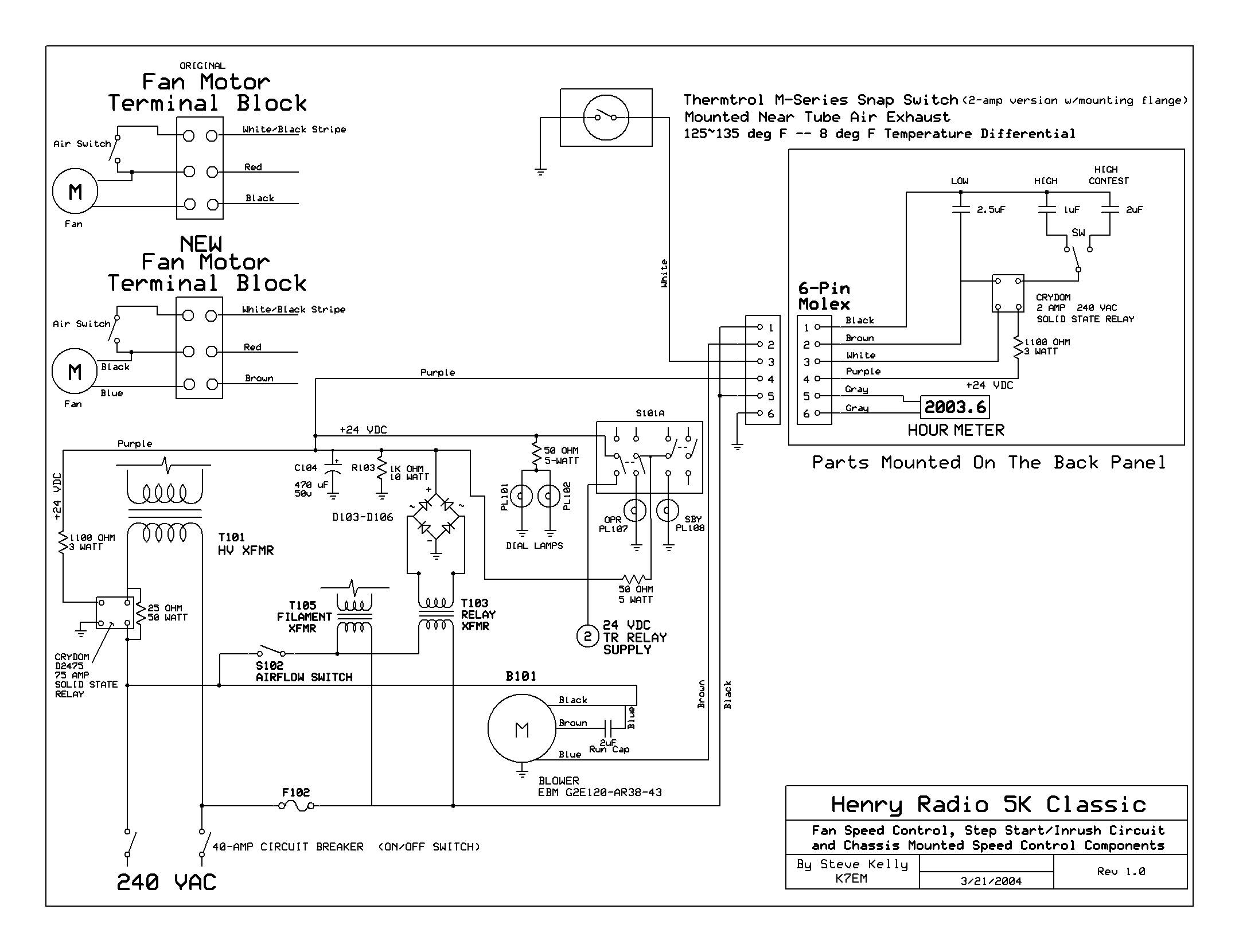
The back cover has been removed, revealing the upper deck of the power supplies and the original Dayton 2C915A blower (220VAC - 140CFM) mounted to the cabinet's underside. The RF deck enclosure has also been taken off. The upper deck of the power supply shows the filament transformer on the front right, the high-voltage filter capacitor at the rear, bleeder resistors positioned at the back right, and the relay/control circuit. After extensive research and measurements, an EBM G2E120-AR38-43 blower was selected as a replacement for the Dayton model. This new blower utilizes a split capacitor motor, which allows for easier speed control by incorporating a capacitor in series with one of the motor leads. Additionally, the external rotor design places the motor at the center of the squirrel cage, resulting in cooler operation. The EBM blower features a cast aluminum housing and maintenance-free ball bearings. An air switch is mounted to activate the tube filaments and relay power supply only when adequate airflow is detected to cool the tubes. The air vane attached to the air switch is also visible. The new blower has a wider squirrel cage, enabling it to move more air at a slower and quieter speed compared to the original Dayton blower. To mitigate vibration issues associated with the original blower, small anti-vibration mounts (Part # 62490-2) were sourced for this application. A mounting plate for the new blower was fabricated from 3/16" aluminum plate. An extension arm on the plate was developed to evenly distribute the blower's weight. A side view of the new blower mount illustrates this setup. Each anti-vibration mount is secured to the plate using four 4-40 screws, while the entire assembly is affixed to the amplifier chassis with 8-32 screws and Ny-Lock nuts. The screws pass through the center brass bushing of each anti-vibration mount, and LockTite was applied to the 4-40 hardware. The installation of the new blower is complete, with a hollow foam weather stripping gasket used to fill the gap between the blower mounting plate and the chassis underside. The gasket is shaped like the letter 'D,' featuring adhesive on the flat side, and its hollow section minimizes vibration transfer. The HV, filament, and control plugs can be seen protruding from the RF deck's bottom. The blower, along with its starting capacitor and terminal strip, has been mounted, mirroring the original blower's setup. The HV, filament, and control cables have been connected to the RF deck. The next phase involves modifying the RF deck to enhance airflow efficiency through the tube anodes. The original exhaust hole above each of the 3CX1200A7 tubes is visible, along with the tube anodes and the white Teflon chimney on top of each tube. Paper templates created in AutoCAD will assist in enlarging each hole, with the original hole being filed out to the first line on the template, the second line indicating the tube anodes' outer diameter, and the outer line representing the diameter of the new chimneys.
The modifications to the RF deck and blower installation are critical for optimizing the thermal management of the system. The use of the EBM G2E120-AR38-43 blower, with its advanced features such as the external rotor design and split capacitor motor, significantly enhances airflow efficiency while reducing operational noise. The implementation of anti-vibration mounts ensures stability and minimizes mechanical noise, which is essential in high-performance applications. The careful design of the mounting plate and the gasket system further contribute to the longevity and reliability of the assembly by preventing potential wear and tear due to vibration. The planned modifications to the RF deck will allow for improved airflow dynamics, ensuring that the cooling requirements of the tube anodes are met effectively. By utilizing AutoCAD for precise template creation, the design process is streamlined, allowing for accurate adjustments to the exhaust holes to accommodate the new chimneys. Overall, these enhancements reflect a thorough approach to improving the performance and reliability of the electronic system.Back cover removed showing the power supplies upper deck and the original Dayton 2C915A (220vac - 140cfm blower) mounted to the underside of the cabinet. The RF deck enclosure was removed. Upper deck of the power supply with the original blower removed. From left to right you can see the Filament transformer, HV filter cap in the rear, Bleeder resistors (back right) and the Relay/Control circuit
transformer (front right). After a great deal of research and measuring, I chose a EBM G2E120-AR38-43 (click link for catalog - 1MB PDF file - see page 19) blower as a replacement for the Dayton. The new blower uses a split capacitor motor which is much easier to speed control by using a capacitor in series with one of the motor leads.
Another advantage is the `External Rotor` design which places the motor in the center of the squirrel cage. The motor runs very cool. The EBM blower has a cast aluminum housing and zero maintenance ball-bearings in the motor. This picture shows the air switch mounted. Henry uses an air switch to turn on the tube filaments and relay power supply only when sufficient airflow is present to cool the tubes.
End view showing the air vane attached to the air switch. The new blower has a much wider squirrel cage which allows it to move more air at a slower, quieter speed than the original Dayton blower. After dealing with all of the vibration problems of the original blower, I decided not to take any chances with the new one.
After more research I found a company that makes small Anti-vibration Mounts ( Part # 62490-2 ) that were perfect for my application. Brad, K7ZSD, made the mounting plate for the new blower out of 3/16" aluminum plate. After further experimenting, it became obvious that an extension arm on the plate would be necessary to properly distribute the weight of the fan.
Here`s a side view of the new blower mount. Each anti-vibe mount is attached to the plate with four 4-40 screws. The entire plate is attached to the amplifier chassis with 8-32 screws and Ny-Lock nuts. The screws run through the center brass bushing in each anti-vibe mount. LockTite was used on the 4-40 hardware. The new blower installed. I used a hollow foam weather stripping gasket to fill the gap between the top of the blower mounting plate and the underside of the chassis. The gasket material is shaped like the letter `D` with an adhesive on the flat side of the `D`. The hollow portion minimizes any vibration transfer between the plate and the chassis. At the top center of this picture you can see the HV, Filament and Control plugs protruding from the bottom of the RF deck.
Here you can see the blower with it`s starting capacitor and terminal strip mounted. The original blower also had the same terminal strip mounted on it. The HV, Filament and Control cables have been plugged into the RF deck. That completes the blower installation. The next step will be the necessary modifications to the RF deck to allow more efficient airflow from the blower through the tube anodes. The original exhaust hole above each of the 3CX1200A7s. The top of the tubes anode is visible at the center of the image. You can also see the white Teflon chimney which sits on the top of each tube. I made paper templates (drawn in AutoCAD) to facilitate the required enlargement of each hole. The original hole was filed out to the first line on the template. The second line represents the tube anodes outside diameter. The outside line represents the outside diameter of the new chimneys. Looking down on the tube sockets wit 🔗 External reference
The modifications to the RF deck and blower installation are critical for optimizing the thermal management of the system. The use of the EBM G2E120-AR38-43 blower, with its advanced features such as the external rotor design and split capacitor motor, significantly enhances airflow efficiency while reducing operational noise. The implementation of anti-vibration mounts ensures stability and minimizes mechanical noise, which is essential in high-performance applications. The careful design of the mounting plate and the gasket system further contribute to the longevity and reliability of the assembly by preventing potential wear and tear due to vibration. The planned modifications to the RF deck will allow for improved airflow dynamics, ensuring that the cooling requirements of the tube anodes are met effectively. By utilizing AutoCAD for precise template creation, the design process is streamlined, allowing for accurate adjustments to the exhaust holes to accommodate the new chimneys. Overall, these enhancements reflect a thorough approach to improving the performance and reliability of the electronic system.Back cover removed showing the power supplies upper deck and the original Dayton 2C915A (220vac - 140cfm blower) mounted to the underside of the cabinet. The RF deck enclosure was removed. Upper deck of the power supply with the original blower removed. From left to right you can see the Filament transformer, HV filter cap in the rear, Bleeder resistors (back right) and the Relay/Control circuit
transformer (front right). After a great deal of research and measuring, I chose a EBM G2E120-AR38-43 (click link for catalog - 1MB PDF file - see page 19) blower as a replacement for the Dayton. The new blower uses a split capacitor motor which is much easier to speed control by using a capacitor in series with one of the motor leads.
Another advantage is the `External Rotor` design which places the motor in the center of the squirrel cage. The motor runs very cool. The EBM blower has a cast aluminum housing and zero maintenance ball-bearings in the motor. This picture shows the air switch mounted. Henry uses an air switch to turn on the tube filaments and relay power supply only when sufficient airflow is present to cool the tubes.
End view showing the air vane attached to the air switch. The new blower has a much wider squirrel cage which allows it to move more air at a slower, quieter speed than the original Dayton blower. After dealing with all of the vibration problems of the original blower, I decided not to take any chances with the new one.
After more research I found a company that makes small Anti-vibration Mounts ( Part # 62490-2 ) that were perfect for my application. Brad, K7ZSD, made the mounting plate for the new blower out of 3/16" aluminum plate. After further experimenting, it became obvious that an extension arm on the plate would be necessary to properly distribute the weight of the fan.
Here`s a side view of the new blower mount. Each anti-vibe mount is attached to the plate with four 4-40 screws. The entire plate is attached to the amplifier chassis with 8-32 screws and Ny-Lock nuts. The screws run through the center brass bushing in each anti-vibe mount. LockTite was used on the 4-40 hardware. The new blower installed. I used a hollow foam weather stripping gasket to fill the gap between the top of the blower mounting plate and the underside of the chassis. The gasket material is shaped like the letter `D` with an adhesive on the flat side of the `D`. The hollow portion minimizes any vibration transfer between the plate and the chassis. At the top center of this picture you can see the HV, Filament and Control plugs protruding from the bottom of the RF deck.
Here you can see the blower with it`s starting capacitor and terminal strip mounted. The original blower also had the same terminal strip mounted on it. The HV, Filament and Control cables have been plugged into the RF deck. That completes the blower installation. The next step will be the necessary modifications to the RF deck to allow more efficient airflow from the blower through the tube anodes. The original exhaust hole above each of the 3CX1200A7s. The top of the tubes anode is visible at the center of the image. You can also see the white Teflon chimney which sits on the top of each tube. I made paper templates (drawn in AutoCAD) to facilitate the required enlargement of each hole. The original hole was filed out to the first line on the template. The second line represents the tube anodes outside diameter. The outside line represents the outside diameter of the new chimneys. Looking down on the tube sockets wit 🔗 External reference
